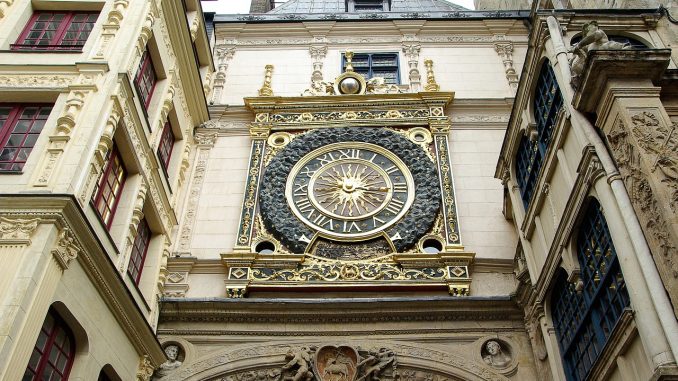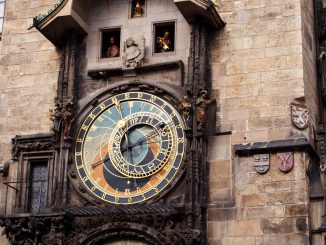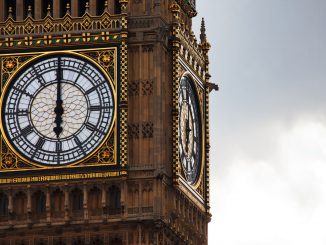
Between a Gothic cathedral made famous by the paintings of Claude Monet, and the old market square where Joan of Arc was burned at the stake, runs a small pedestrian street known as Rue du Gros-Horloge. This quaint street in Rouen, the capital city of the region of Normandy, France, with its many timber-framed buildings is named after Le Gros-Horloge, a Renaissance clock set in an arch over the street. The 14th century astronomical clock is one of the most well-known and oldest clocks in the world, and is by far the most famous clock in France. This popular tourist attraction and local landmark in the old town of Rouen is flanked by a Gothic belfry, and surrounded with hundreds of years of history.
Installed in a Renaissance arch crossing the Rue du Gros-Horloge in Rouen, France, the 1389 mechanism is also one of the oldest in the country. Construction of Gros-Horloge was started by Jourdain del Leche and finished by the more expert Jean de Felain who would become the first person to hold the position of the governor of the clock. The cast iron movement is approximately twice the size of the Wells Cathedral Clock and is perhaps the largest of this type of mechanism to still exist. The mechanical mechanism was fully operational from the 14th century all the way through the 1920s when it was converted to run on electricity. Today, the interior of the clock and the neighboring belfry are open to the public as a popular historical museum.
When it was constructed, as was common at the time, there was no dial on the clock and time was told by the chiming of the bells. It was not until the 1527 construction of the arch where the clock rests today that a dial was added to both sides of the arch in 1529. It allowed people to be able to tell the time whenever they wanted instead of relying on the bells, but the bells were still a necessity since most people couldn’t tell time. Since there was enough people in the area that relied on the ringing of the bells to know when it was time to go about their daily routine, the bells continued along with the new dials.

A single hand, moving over 24 golden sun-rays encircled with a blue starry night points out the hour of the day. While the clock tells the time, it’s also rich in astronomical symbolism, and the phases of the moon are indicated on a small sphere directly above the dial. On the opposite side below the VI, a panel reveals the day of the week, with each day represented by the god of that specific day. Monday is represented by the Moon, Tuesday by Mars, Wednesday by Mercury, Thursday by Jupiter, Friday by Venus, Saturday by Saturn, and Sunday is indicated by everybody’s favorite, Apollo.
The city of Rouen was heavily damaged during the second World War, but still has some incredibly well preserved Medieval and Renaissance sites.
Visiting Le Gros-Horloge
- A ‘behind the scenes’ tour of Le Gros-Horloge is possible The entrance to the clock is at the base of the belfry (opening hours vary throughout the year, so check the website).
- Entrance is free of charge for children ages less than 6, disabled people.
- Gros-Horloge does not have locker rooms and luggage storage, which is inconvenient (though understandable) because they also don’t allow in large bags.
- And audio-guide is included (French and English) lasting about 40 minutes, and takes the visitor through the belfry and the pavilion, the dials room, the bells chamber, and the clockmaster’s workshop and flat.
- The city of Rouen is 8.255 square miles.
Le Gros-Horloge Facts
- The mechanism for the Gros-Horologe was made in 1389. That makes it not only one of the oldest working clocks in Europe but one of the oldest mechanical clocks in the world.
- The 2.5 meter diameter face of the clock was added in 1529 when the clock was moved to its current location.
- Prior to the 18th century clocks were masculine, so Le Gros-Horloge is a masculine phrase. If it were built today it would have been known as La Gros-Horloge since clocks are feminine.
- The Gros-Holroge underwent a complete restoration in 2006.
- The bells in the belfry were the first set of municipal bells in Rouen.
- Each dial is about two and a half meters in diameter.
- The Gros-Horloge is sometimes called “The Pride of the People of Rouen”.
- The moon phases are indicated in the oculus above the clock face and completes a full rotation in 29 days.


